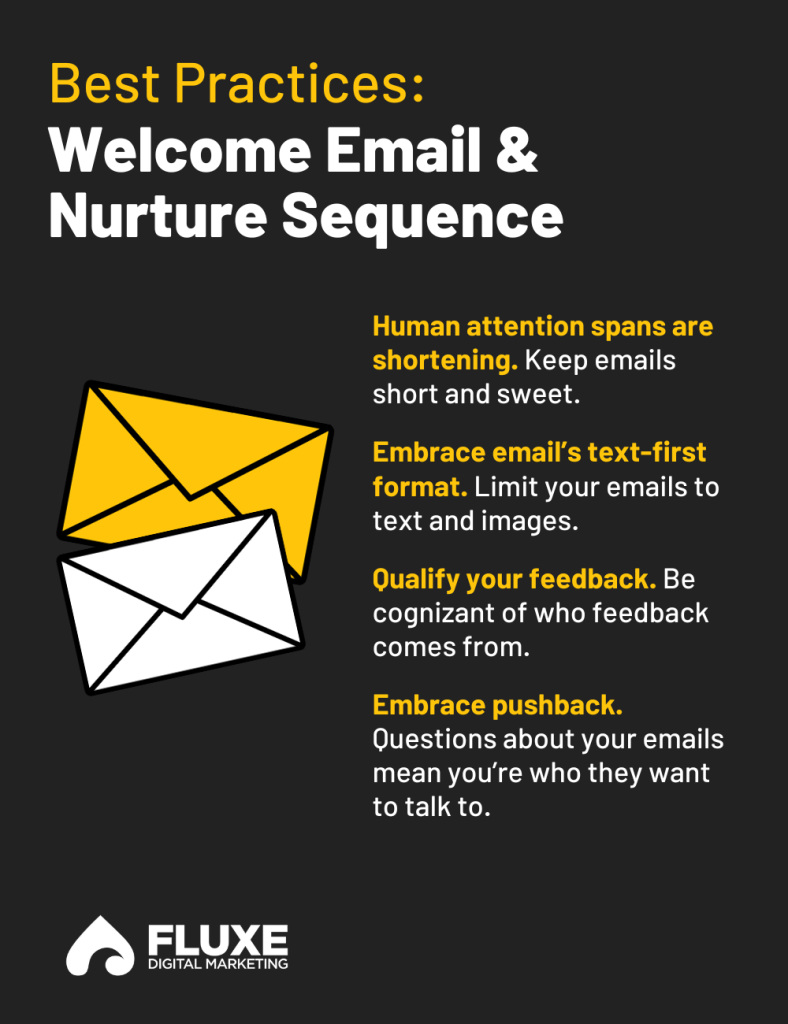Your email contact list is the only marketing channel you own.
You may think you own a certain number of SEO keywords that draw organic traffic to your site, but you don’t own the algorithm that ranks them. Google does, and Google can change the rules at a moment’s notice.
The same is true for social media. You may think you own your thousands of followers, subscribers, etc., but you don’t own those algorithms or channels. You simply have access to them — and they can disappear overnight.
But once you have someone’s contact information (and permission to use it), you own it. You can always leverage it, no matter what.
If you’re like most business owners, you think of content marketing as assets that live on your website and social media. Email marketing is different. It’s not something someone can stumble upon while they’re tumbling down an internet rabbit hole. It’s outbound marketing — sending an asset directly to prospects who are already interested.
You know you need to welcome and nurture those contacts to draw them further down your sales funnel, but you don’t know how to get started. How much is too much to give away in a single email? How do you add value to your contact list? How often do you send emails? How do you choose topics strategically? Does every email need to include action steps?
Every marketer has a thousand unique recommendations for welcome email best practices. These are the ones we’ve found work best for our clients. We’ll focus specifically on welcome sequences and nurture sequences.
What Is a Welcome Sequence?
When someone raises a hand and says, “I want to receive emails,” the first handful they receive makes up what’s called a welcome sequence.
There are many ways someone can join your contact list — through a contact form on your website, by downloading a lead magnet, by meeting you at an in-person networking event, etc. Consent is key here. Don’t slam someone with messages they never asked for; it’s ineffective.
A welcome sequence introduces a new member of your contact list to your brand. Use these emails to introduce yourself, highlight the value you provide, outline what you do and who you do it for, and explain what differentiates you from your competitors.
An effective welcome email sequence does a lot of the heavy lifting in answering questions about who you are, what you can do for them, and whether they actually like getting emails from you.
What Is a Nurture Sequence?
A nurture sequence comprises emails that add value to your list on an ongoing basis. While a welcome sequence is finite, a nurturing sequence is infinite. It’s a continuous drip of value that happens at a step frequency.

Welcome Email Best Practices
An initial welcome email should:
- Welcome new members
- Introduce yourself
- Provide what you promised
- Convey excitement
- Set expectations
If the new contact requests a free resource from your website, your first communication must deliver it. If you don’t position yourself as a promise-keeper, you’ll never earn their trust.
End by setting an expectation for future correspondence. “I’ll be sending you some resources over the next few weeks. Keep an eye on your inbox!” Everyone expects this when they give their email address to a company. Affirming this expectation early shows that you respect the reader’s time and their valuable email real estate.
In your second email, discuss some common problems your product or service solves. Rather than sending a straightforward list of your offerings, lead with your benefits — your “so that,” as we call it.
The biggest benefit you offer is the relief of solving a problem. Call out the problems your reader experiences and let them know how you can solve them. Doing so highlights the reasons you’re in business, even beyond making money.
Let’s say you’re a concierge healthcare provider. People new to concierge medicine have suffered from a lack of access and quality care in the conventional medical system. You could say, “We offer 24/7 physician access,” but that doesn’t speak directly to those problems. Instead, say, “We offer 24/7 physician access so that you get real-time recommendations from your doctor in urgent situations, like when your child comes home from football practice with a suspected broken finger.”
Another of our welcome email best practices is to redirect readers to high-value content on your website — your most popular blog posts, your FAQ page, etc.
“But Trae,” you say, “people can find those links themselves!” Sure. They’re all grown up and more than capable of scouring your website on their own. But it’s highly unlikely that they’ll find everything YOU think is important if they look for it at all. Instead, make it easy for them.
Your welcome sequence is also an excellent place for high-value content you’ve already put time and effort into. I can’t count the number of times I’ve seen a business owner make a brilliant piece of content, send that content out as a newsletter, and then never use it again. New prospects join your contact list all the time. Give your older, established content new life by leveraging it in your welcome sequence.
Finally, use your welcome sequence to highlight your differentiators. Why are you proud of this company? Finding new, creative ways to write about your core values and uniques conveys transparency about your company and proves you’re a like-minded, value-driven individual worthy of doing business with.
Nurture Sequence Best Practices
Like a welcome sequence, a nurture sequence demonstrates value, answers questions, and solves problems. Unlike a welcome sequence, it does so on an ongoing basis.
In nurture sequences, consistency is key! Regular emails keep you top of mind, which is the most important goal. A lot of businesses pay close attention to email metric data. They want to use open rates and clickthrough rates to gauge whether their nurture sequence works. But open rates are only one measure of success.
Here’s how we see it: An email is being delivered to a contact’s inbox. They see your name attached to it, and it takes up space in their mind. That’s huge. If they don’t sign up for your services immediately or even open the email, that doesn’t mean your nurture sequence lacks value.

Nurture Sequence and Welcome Email Best Practices: Final Tips
Human attention spans are shortening. Some prospects want to read 1,000-word emails, but most don’t. To keep emails short and sweet, include a brief blurb about a topic, followed by a link to a more in-depth resource on your website. “If you’d like to dive deeper, click here.”
Embrace email’s text-first format. Videos are a great way to engage an audience, but try not to embed them directly. Instead, let them live on a video platform and link to them. Try to limit your email real estate to text and images.
Qualify your feedback. Remember that all feedback is good feedback (even if it’s not the most positive), but be cognizant of who the feedback comes from. People who aren’t part of your target market (colleagues of colleagues, etc.) may be the first to give feedback on your email sequence. Be open-minded, but don’t be quick to change your strategy for people who aren’t in your target audience.
Embrace pushback. If an existing client disagrees with something you said in a recent email and pushes you to debate the topic, that’s a sign of positive engagement. We know this type of engagement can make business owners nervous: “Quick, we need to change our strategy!” But if a client is asking questions about your email, it means you’re the one they want to talk to, and your nurture sequence is doing its job.
If you aren’t educating and engaging your audience, someone else is. Take advantage of the only channel you own and put it to work for you.



